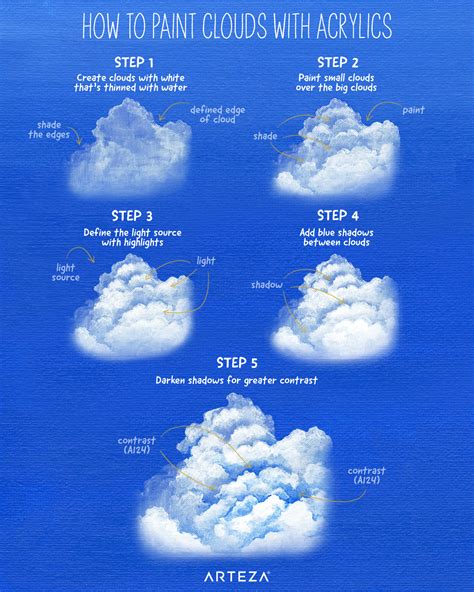How to Paint Clouds: A Guide for Beginners and Beyond
Clouds. Those fluffy, ever-changing shapes in the sky. Capturing their ethereal beauty on canvas can seem daunting, but with the right techniques and a little practice, anyone can learn how to paint clouds. This guide will walk you through the process, from choosing your materials to mastering different cloud types.
Choosing Your Materials: The Foundation of Success
Before you even think about mixing colors, gather your supplies. The right materials significantly impact your painting experience and the final result.
Essential Supplies:
- Paints: Acrylics are a popular choice for beginners due to their quick drying time and water-solubility. Watercolors offer a delicate, translucent effect, perfect for capturing the soft glow of clouds. Oils provide rich depth and blending capabilities but require more patience.
- Brushes: A variety of brush sizes is essential. Larger, flat brushes are ideal for laying down base colors and creating broad strokes. Smaller, round brushes allow for more detailed work and texture. Consider synthetic brushes for acrylics and watercolors, and natural hair brushes for oils.
- Canvas or Paper: Choose a surface that complements your chosen paint. Canvas is durable and provides a textured surface, while watercolor paper is specifically designed to handle the wet-on-wet technique.
- Palette: A palette helps keep your colors organized and easily accessible.
- Water Container: Essential for cleaning brushes and diluting paints.
- Palette Knife: Useful for mixing paints and creating texture.
- Paper Towels: For cleaning up spills and excess paint.
Mastering Cloud Techniques: From Simple to Stunning
Painting realistic clouds isn't about perfect replication, but capturing their essence. Here's a breakdown of techniques to help you achieve various cloud types.
1. Layering for Depth and Dimension:
This technique is crucial for creating realistic clouds. Start with a light base color (usually a pale blue or gray), then gradually add layers of lighter and darker tones to build depth and dimension. Remember, clouds are rarely uniformly colored.
2. Wet-on-Wet for Soft Edges:
For a soft, diffused look, apply a wet wash of color to your canvas, then add more color while it’s still wet. This creates a seamless blend, ideal for fluffy cumulus clouds. This technique works particularly well with watercolors.
3. Dry Brushing for Texture:
Dry brushing involves using a nearly dry brush with a small amount of paint. This creates a textured, wispy effect, perfect for capturing the delicate details of cirrus clouds.
4. Using a Palette Knife for Dramatic Effects:
A palette knife can be used to create interesting textures and dramatic strokes, particularly for stormy cumulonimbus clouds. Experiment with different pressure and angles to achieve varied results.
Painting Specific Cloud Types:
Different cloud types require slightly different approaches. Here are a few examples:
Cumulus Clouds: These fluffy, cotton-like clouds are best achieved using the wet-on-wet technique and layering lighter and darker shades of white and gray.
Cirrus Clouds: These wispy, feathery clouds are created using dry brushing and delicate strokes with thin washes of white and gray.
Stratus Clouds: These flat, gray clouds are best painted with broad, even strokes of a muted gray or blue.
Cumulonimbus Clouds: These dark, towering storm clouds require bold strokes and a contrast of dark and light shades, often employing the palette knife for textural effects.
Tips for Success:
- Observe real clouds: Spend time observing clouds in the sky. Pay attention to their shapes, colors, and how light interacts with them.
- Practice makes perfect: Don't get discouraged if your first attempts aren't perfect. Keep practicing, and you'll gradually improve your skills.
- Experiment with different techniques: Try different brushes, paints, and techniques to find what works best for you.
- Reference photos: Use reference photos to help guide your painting, but don't be afraid to add your own creative touch.
- Don't be afraid to make mistakes: Mistakes are part of the learning process. Embrace them and learn from them.
By following these steps and practicing regularly, you'll be well on your way to creating stunning and realistic cloud paintings. Remember, the key is to observe, experiment, and have fun!
